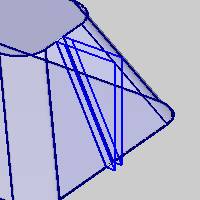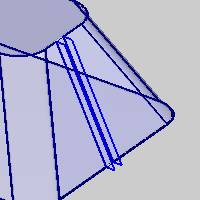 Wire EDM Leads
Wire EDM Leads
Introduction
This topic explains the Leads page of the following operations found in the Wire 2 Axis, and 3 Axis Wizards:
- 2 Axis Rough Cut
- 2 Axis Tab Cut
- 2 Axis Skim Cut
- 4 Axis Rough Cut
- 4 Axis Tab Cut
- 4 Axis Skim Cut
 Leads
Leads
Entry
Start Hole
-
Diameter - is the diameter of the hole drilled for the purpose of threading the wire. For coreless operations, no wirepath is generated within this area.
Thread Wire
- Thread Vertical
 Select the check box to force the upper and lower guides to align vertically
at the beginning of the lead-in of the operation.
Select the check box to force the upper and lower guides to align vertically
at the beginning of the lead-in of the operation. Clear the check box to allow the upper and lower guides to use the alignment
as defined by the operation. For example, with taper applied to a 2-axis
operation, the upper and lower guides are aligned with the same angle,
unless you turn on Thread Vertical.
Clear the check box to allow the upper and lower guides to use the alignment
as defined by the operation. For example, with taper applied to a 2-axis
operation, the upper and lower guides are aligned with the same angle,
unless you turn on Thread Vertical.

Lead-in
Type
Select from one of the following lead-in types to define the lead-in for the operation.
-
Circular - creates a linear move followed by an arc sweep into the start of the operation using the specified Radius and Length. The linear move is created at a right angle to the arc sweep.
-
Radius - sets the radius of the arc portion of the lead move.
-
Length - sets the distance of the linear portion of the lead move.
-
Perpendicular Blend - creates a linear move followed by an arc sweep into the start of the operation using the specified Radius and Length.
-
Radius - sets the radius of the arc portion of the lead move.
-
Length - sets the distance of the linear portion of the lead move.
-
Perpendicular - creates a linear lead move at a right angle to the profile using the specified Length.
-
Length - sets the distance of the lead move from the feature profile.
-
Parallel - creates a lead move that is parallel to the feature profile using the specified Length.
-
Length - sets the distance of the lead in move from the start of the operation.
-
Select Point - creates a linear lead move from the specified point to the start of the operation.
-
First Point X - sets the X-axis value of the point. You can type the value here, or use Pick Points to automatically set the value from the selected point.
-
First Point Y - sets the Y-axis value of the point. You can type the value here, or use Pick Points to automatically set the value from the selected point.
-
Point Blend - creates a linear feed move followed by an arc sweep into the start of the operation using an arc Radius and the specified point.
-
Radius - sets the radius of the arc move into the start of the operation.
-
First Point X - sets the X-axis value of the point. You can type the value here, or use Pick Points to automatically set the value from the selected point.
-
First Point Y - sets the Y-axis value of the point. You can type the value here, or use Pick Points to automatically set the value from the selected point.
-
Pick Points - enables selection mode for you to select the lead point from geometry in the Workspace. This option is available for both Point Blend and Pick Points. Be sure to read the following note.
Tip: The Pick Points button serves a dual purpose that depends on the number of profiles (shapes) selected for the feature. When you assign a single shape to the feature, this option is used to select a single point. When you assign more than one shape to the feature, you can select one point for each shape to define the lead point for each.
Coreless Thread Point
When you create a coreless operation, the Lead-in group changes to the Coreless Thread Point group with the following options.
Type
-
Automatic - the thread point is automatically set to start at the deepest offset of the feature when no Start Hole is defined. For example, with a circular hole, the wire starts just outside of the center of the hole. When you define the Start Hole diameter, the wire starts from the center of the start hole location.
-
Select Point - allows you to define the thread point either by typing values or selecting point geometry.
-
First Point X - sets the X-axis value of the point. You can type the value here, or use Pick Points to automatically set the value from the selected point.
-
First Point Y - sets the Y-axis value of the point. You can type the value here, or use Pick Points to automatically set the value from the selected point.
-
Pick Points - enables selection mode for you to select the thread point from geometry in the Workspace. Select one point to define the thread point location.
Lead-out
-
Same As Lead-in (This option is not available for Rough Cut operations set to Coreless.)
![]() Select this check
box to use the Lead-in settings to automatically set the Lead-out settings.
Select this check
box to use the Lead-in settings to automatically set the Lead-out settings.
![]() Clear the check box to set the Lead-out independently from the Lead-in.
Clear the check box to set the Lead-out independently from the Lead-in.
Type
Select from one of the following lead-out types to define the lead-out for the operation.
-
Circular - creates an arc sweep move followed by a linear move out of the operation using the specified Radius and Length. The linear move is created at a right angle to the arc sweep.
-
Radius - sets the radius of the arc portion of the lead move.
-
Length - sets the distance of the linear portion of the lead move.
-
Perpendicular Blend - creates an arc sweep move followed by a linear move out of the operation using the specified Radius and Length.
-
Radius - sets the radius of the arc portion of the lead move.
-
Length - sets the distance of the linear portion of the lead move.
-
Perpendicular - creates a linear lead move at a right angle to the profile using the specified Length.
-
Length - sets the distance of the lead move from the feature profile.
-
Parallel - creates a lead move that is parallel to the feature profile using the specified Length.
-
Length - sets the distance of the lead move from the end of the operation.
-
Select Point - creates a linear lead move from the end of the operation to the specified point.
-
First Point X - sets the X-axis value of the point. You can type the value here, or use Pick Points to automatically set the value from the selected point.
-
First Point Y - sets the Y-axis value of the point. You can type the value here, or use Pick Points to automatically set the value from the selected point.
- Perpendicular to Closest - with Select Point chosen as the lead type, the Perpendicular to Closest option will become available.
 - will move from the selected point, to the start of the chain defined as the geometry of the feature.
- will move from the selected point, to the start of the chain defined as the geometry of the feature.  - will move from the selected point, in a perpendicular motion, directly to the closest entity defined as the geometry of the feature.
- will move from the selected point, in a perpendicular motion, directly to the closest entity defined as the geometry of the feature. -
Point Blend - creates an arc sweep move followed by a linear move out of the operation using an arc Radius and the specified point.
-
Radius - sets the radius of the arc move out of the operation.
-
First Point X - sets the X-axis value of the point. You can type the value here, or use Pick Points to automatically set the value from the selected point.
-
First Point Y - sets the Y-axis value of the point. You can type the value here, or use Pick Points to automatically set the value from the selected point.
-
Pick Points - enables selection mode for you to select the lead point from geometry in the Workspace. This option is available for both Point Blend and Pick Points. Be sure to read the following note.
Tip: The Pick Points button serves a dual purpose that depends on the number of profiles (shapes) selected for the feature. When you assign a single shape to the feature, this option is used to select a single point. When you assign more than one shape to the feature, you can select one point for each shape to define the lead point for each.
- Force Vertical - When using 4 Axis operations, this option allows you to dictate whether to end the operation at a taper matching that of the profile, or to move the wire back into a vertical position.
 - will allow the wire to remain at the angle matching the angle found at the end of the profile.
- will allow the wire to remain at the angle matching the angle found at the end of the profile.  - will force the wire back into a vertical position at the end of the profile.
- will force the wire back into a vertical position at the end of the profile. - Overlap Amount - sets the amount of overlap between the start and end of the operation for Skim Cuts operations only. This is used to remove any scallop that may be created when not using an overlap.
Next Topic
After defining the Leads for the operation, click Next>> to go to the Cutting Conditions.
